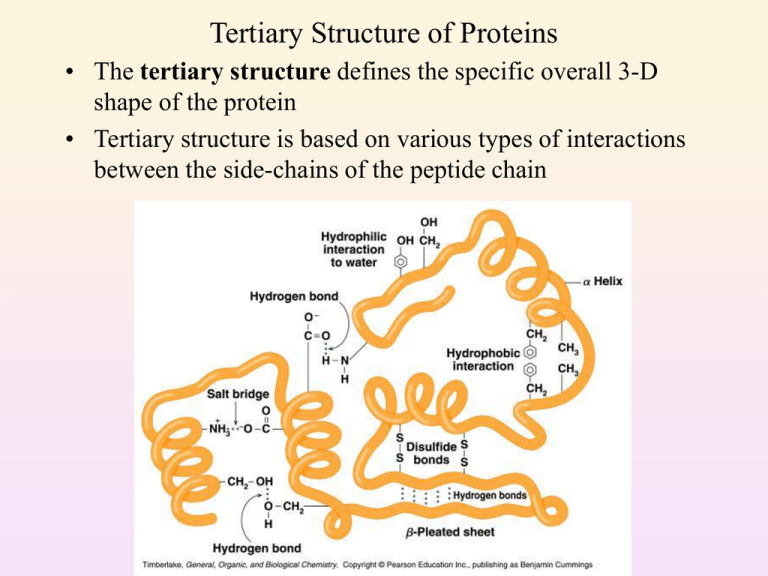The three-dimensional structure of a protein is called Tertiary Structure. Hydrophobic interactions greatly contribute to the folding and shaping of a protein.

Tertiary Structure Of Proteins
It includes beta pleated sheets as a common form.

. It includes alpha helices as a common form. Start studying tertiary structure and protein folding. The tertiary structure of a protein are formed by coiling and folding of chains of proteins which are held together by the weak non-covalent interacting formed between various parts of the polypeptide chain.
The sequence of amino acids in a protein the primary structure will determine where alpha helices and beta sheets the secondary structures will occure. This final shape is determined by a variety of bonding interactions between the side chains on the amino acids. They are usually stable but do not conform to any frequently recurring pattern.
Fibrous mainly 4 types. The tertiary structure is created by several types of bonds between the amino acids. These are both local structures.
Which of the following statements describes the tertiary structure of a protein. Which of the following statements best describes the tertiary structure of a protein. KERATIN IS MADE UP OF TWO RIGHT HANDED HELICES BUT IT MAKES A LEFT HANDED COIL.
The insulin molecule shown here is cow insulin although its structure is similar to that of human insulin. Hydrogen bonds occur between polar amino. A string of amino acids bonded together multiple polypeptides bonded together nucleotides bonded together that are also twisted a three dimensional structure of a polypeptide Which macromolecule is provides the least amount of energy.
Tap card to see definition. To some extent the tertiary structure is determined by the amino acid sequence of the primary structure. The tertiary structure of a protein refers to the three-dimensional arrangement of its polypeptide chain in space.
Two or more polypeptide chains interacting to form a higher-order structure. Learn vocabulary terms and more with flashcards games and other study tools. The tertiary structure is maintained by many.
Yes alpha helix and beta sheets are secondary structures wand when peptide chains containing these structures fold again by virtue of bond formation Hydrogen bonds Hydrophobic interaction van-der-wall interactions ionic bonds and covalent bonds they form the 3D model of a protein that is termed as. Is the number and arrangement of multiple folded protein subunits in a multi-subunit complex. A protein can have one or more domains.
Biology questions and answers. What helps stabilize tertiary structure of a protein. They are strongly influenced by side chain groups.
The third type of structure found in proteins is called the tertiary structure of the protein. These binding interactions may be stronger than. The tertiary structure is the final specific geometric shape that a protein assumes.
H bonds are key to defining protein structure and necessary to remain stable. Which of the following best describes the tertiary structure of proteins. Best way to pack the space in folded protein while compensating for lost interactions with water.
Free energy from removal of what compound from water. CIt involves hydrogen bonding between amino acid side- chains. Tertiary structures involve packaging the secondary structures into compact globular regions called protein domains.
Unfolded proteins cause H20 water cages which are very unfavorable. The R group of the amino acid is either hydrophobic or hydrophilic. The polypetides chain that forms a 3-dimensional structure is called as secondary structure.
Keratin two right handed coils to make a left. Which statement below best describes the tertiary structure of a protein. Tertiary Structure refers to the comprehensive 3-D structure of the polypeptide chain of a protein.
The Tertiary Structure of a protein is the arrangement of the secondary structures into this final 3-dimensional shape. The structure formed from interactions between the amino acid side groups. Enzymes transport proteins antibodies cell surface proteins integral membrane proteins virus coat proteins storage proteins DNA binding proteins.
Click card to see definition. There are several types of bonds and forces that hold a protein in its tertiary structure. It gives rise to two.
The tertiary structure of a protein is the three-dimensional shape. Driving force for protein folding. For instance in globular proteins the polypeptide chains are held together in a definite way forming a compact structure.
Linear protein folded into alpha helices and beta- pleated sheets. Tertiary structure of a protein describes A The order of amino acids B Location of disulphide bonds C Loop regions of proteins D The ways of protein folding. The interactions between the side chains in a protein result into its tertiary structure.
For example the hormone insulin has two polypeptide chains A and B shown in diagram below. Make sure you know the secondary structures that make up the tertiary structures. It involves hydrogen bonding between the backbone atoms.
Specific biological activities such as enzyme activity are associated with the tertiary structure. A The tertiary structure of a protein is the folded structure alpha-helix or beta-sheet formed by additional bonds that are formed in the polypeptide chain. The simplest level of protein structure primary structure is simply the sequence of amino acids in a polypeptide chain.
Amino acids linked by peptide bonds. Water molecules H-bonding with the surface. What are some functions of globular proteins.
The tertiary structure of proteins represents overall folding of the polypeptide chains further folding of the secondary structure. 3D globular structures stabilized by covalent disulfide bridges.
How Is The Tertiary Structure Of Protein Formed Quora

Tertiary Structure Protein Structure Tutorials Msoe Center For Biomolecular Modeling

0 Comments